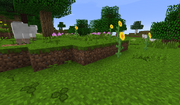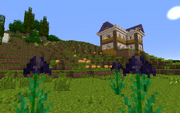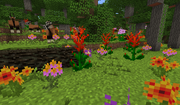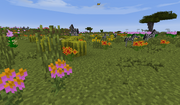Common Vegetation, in the definition used here, are plants that are abundantly present, 'common', in many biomes and/or larger regions of Middle-Earth.
The motive for this page is to avoid long lists of plants in the biome infoboxes on the biome pages. The purpose is to:
- provide info on the occurrence of these plants in biomes of Middle-Earth and to
- provide links to more detailed information on any common plant.
In most cases, the 'vegetation' section of the biome infoboxes will contain one or more link(s) to the groups of common vegetation mentioned below.
The 'common vegetation' is divided in a few logical groups that correspond to their occurence in larger regions of Middle-Earth. This division may change as more plants are added with new mod updates. For now, we distinguish between the following groups of common vegetation:
Global: Berry Bush, Pumpkin, Flax, Reed, Sugar Cane, Thistle, Mushroom, Dandelion, Poppy, Lily Pad, LOTR Grasses, Clover and Grasses and Ferns.
Temperate: Bluebell, Marigold, Blue Orchid, Allium, Azure Bluet, Tulips, Oxeye Daisy, Sunflower, Lilac, Rose Bush and Peony.
Tropical: Melon, Flame of Harad, Harad Daisy, Hibiscus, Sand Gem and Southbell.
Some plants grow only in a limited number of biomes. Their occurence is specifically mentioned in every relevant biome infobox.
A number of biomes/regions, particularly evil and/or very inhospitable lands, has no common vegetation at all, except grasses. These are: HOLD.
Global[]
The common vegetation in this category is spread across entire Middle-Earth. Typically these are either of hardly any use, or a unique source for a resource.
Berry Bush[]
Berry bushes are a valuable source of quick bites and road trip snacks. Varieties of berry bushes grow wherever there is a grassy top soil.
Pumpkin[]

Shire - Pumpkins, Wheatgrass and Poppies.
Pumpkins are the only source for the casing of Jack'o'Lanterns and the filling of delicious Pumpkin Pie. For the latter delicacy, the presence of egg-laying common animals would be handy.
Flax[]

Shire - Flax, Flowery Grass, peony and Rose Bushes
Flax is a valuable resource and found in a great many grassy and forested biomes. For many peoples, it is the only available source of string and for the people in Far Harad it's the only resource for wool.
Reed[]
Reed can be found in many biomes in shallow waters, along river banks and lakes and in all other shallow water bodies. It's most abundantly present in swampy biomes and biome variants.
Sugar Cane[]

Ninidalf - Cane, Reed, Lily Pads, Ferns and Grasses
Sugar Cane can be found along sandy shores of any body of water, be it flowing or stagnant. It's most abundantly present along river banks and lakes and in all sandy swampy biomes and Biome Variants. It the only source providing Sugar and Paper.
In the renewed version, they can only be found in Harad and southern Gondor.
Thistle[]
Thistle can be found wherever there is a grassy top soil and is one of the most abundant decorative and annoying (unless you're not running through them) plants of Middle-Earth.
Mushroom[]
The temperate zone offers plenty of moist and shady places for Mushroom to thrive, but so does the underhome in the tropical parts of Middle-Earth. These tasty stew ingredients can be found in practically all forested biomes and biome variants, and in many a cave anywhere on Middle-Earth.
Dandelion & Poppy[]
The most common flowers of Middle-Earth are the Dandelion and Poppy. Anywhere flowers blossom, these two pests manage to find a way to mingle with the locals, making them the most predominant global flowers.
Lily Pad[]
Pad Lily Pad can be found in all swampy biomes and Biome Variants in fens, slow flowing brooks, rivers and lakes. With Riverweed, it is the only material that enables 'walking on water'.
In the renewed version, they can have one of four colours of flower atop them, and they don't spawn in the Mouths of Anduin.
Grass[]
These grasses are all LOTR types of grass and can be found wherever there is a top soil that can support them. This even holds for the most barren landscapes that basically only feed pale and dry looking short grasses. They are the main sources of nourishment for herbivorous Common Animals of Middle-Earth. Notable types are: Wheatgrass, Flowery Grass & Short Grass.
Clover[]

Shire - Clover, Thistle and Sunflowers
Clovers are also found anywhere there is a fertile top soil. They are the favourite snack of rabbits.
Vanilla Grasses and Ferns[]
These are a group of Vanilla Minecraft plants that fill up any empty area where the notion of 'fertility for the land' is to be nourished by providing '3D' structures that wave in the winds and hide small animals from the view of any possible omnivore or carnivore.
Rushes[]
Rushes are decorative plants found in shallow water in the renewed version only. They have no other uses.
Temperate[]
The plants in this group are typically found in the biomes in between the Forodwaith to the north and Near Harad to the south, including Umbar.
Biomes where these flowery plants cannot be found are: Dead Marshes, Dunland, Emyn Muil, Grey Mountains, Harondor, Iron Hills, Lothlórien, Midgewater, Mirkwood Corrupted, Misty Mountains, Mordor, ... (HOLD: List to be completed!)
Bluebell[]
This lovely blue flower generates in many of the temperate zones cooler biomes, in forests and on plains.
Marigold[]
This lovely orange coloured gem can be found in many temperate plains and forested areas.

Dorwinion - Black Iris, Chrysanthemum and Marigold
Blue Orchid[]

Tundra - Blue Orchids, Berry Bushes and Shortgrass
The Blue Orchid is a flower that flourishes in swampy biomes and swampy biome variants.
Allium[]
The Allium is one of the rarest common plants in the temperate zone. It flourishes in flower variants of any forest biome or biome variant.
Azure Bluet[]
The azure bluet flourishes in flower beds of plains and generally flower-rich biome variants.
Tulip[]
Tulips come in a range of colourful varieties and grow in many plains and flowery biome variants in the temperate zone.
Oxeye Daisy[]
The oxeye daisy can be found along with azure bluets and tulips in many flower beds of the plains and flowery biome variants.
Sunflower[]

Field of Celebrant - Name temperate flowers that are not in this picture!
There is no Sunflower Field biome variant in Middle-Earth, yet, sunflowers can be found in plains and flowery biome variants.
Lilac[]
The lilac flower can be found in flower beds and in the undergrowth of many forest type biomes and flowery and forested biome variants of Middle-Earth.
Rose Bush[]
Rose bushes grow in forested biomes and flowery and forested biome variants.
Peony[]
The bright peony can be found alongside of lilac and rose bushes in flower beds and under the canopy of nearly all temperate plains and forests, hiding both predator and prey form each others view.
Tropical[]
The plants in this group are typically found in the biomes south of Harondor, Mordor and Rhûn, excluding Umbar. Notable exception is the Perdorogwaith.
Melon[]

Far Harad Forest - Flame of Harad in a flower bed
Melon is a very useful crop of the tropics and can be found in any wet and warm environment on soils fertile enough to boost their big, round fruits.
Flame of Harad[]
The Flame of Harad has long been a favourite ornament on the head gear of both warrior chieftains and political rulers of Harad tribes. It grows almost anywhere in soil fit for growing green grasses, and where the stars shine strange.
Harad Daisy[]

Near Harad Fertile - Harad Daisy and Hibiscus
The Harad Daisy makes for fine ornamental plants in many a Harad household and can also be used as a resource for dye. It grows almost anywhere in soil fit for growing green grasses, and where the stars shine strange.
Hibiscus[]
The Hibiscus makes for fine ornamental plants in many a Harad household and can also be used as a resource for dye. It grows almost anywhere in soil fit for growing green grasses, and where the stars shine strange.
Sand Gem[]

Far Harad Savannah - Sand Gems, Melon and Southbells
The Sand Gems come in two colours, make for fine ornamental plants in many a Harad household and can also be used as a resource for dyes. It grows almost anywhere in soil fit for growing green grasses, and where the stars shine strange.
Southbell[]
The Southbell makes for fine ornamental plants in many a Harad household and can also be used as a resource for dye. It grows almost anywhere in soil fit for growing green grasses, and where the stars shine strange.
Papyrus[]
This plant (found in the renewed version only, is very similar to the reeds found across Middle-earth, and grow across Harad wherever there is water.
|
|
